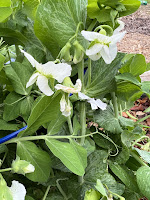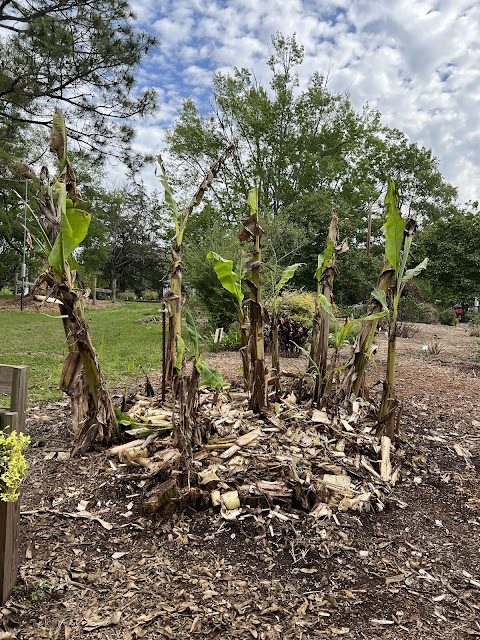 |
| Bananas after a moderately cold winter |
Bananas are a grass and their upright portion is called a pseudostem. Because it functions as a trunk, that’s what we’ll call it. Bananas plants grow from rhizomes with many growing points. The entire stand of bananas is called a mat.
Unless it was an exceptionally cold winter and your bananas are mushy all the way to the ground and stinky, cut off only those parts which look dead and leave anything that is still green or firm as a base for new growth. Leave pruning debris on the ground around the mat as mulch and nutrition for the remaining plants. Chop up heavier parts to allow them to decompose more quickly. Banana prunings also make excellent additions to your compost bin. Preferred tools for cutting bananas are machete, handsaw, or reciprocating saw. Don’t use your chainsaw as the moist, stringy material in the trunks will make a big mess in your saw chain.
 |
| Cold damaged unharvested immature bananas |
If your banana plant has produced bananas of any type, whether mature or not, cut the trunk all the way to the base. It will not make bananas again, and you do not want the mat to waste energy sustaining a plant that will not bear fruit. To keep these non-productive plants from regrowing, use a piece of rebar or another sharp object to kill the bud in the center of the stump.
The ideal population of a mat is three banana plants — one fully grown bearing-size, one second year plant which is about half grown, and one new shoot. With a large mat, this can be extended to about twice that number with adequate water and nutrition, but leaving more will reduce fruit production. It takes anywhere from six to 20 months for a banana plant to bear a mature stalk of bananas, depending on the weather, water, nutrition, and density of the mat.
 |
| Thinning out the mat |
For the difference between bananas and plantains, banana varieties, plant care, when to harvest, how to ripen, and much additional information about growing bananas in your food forest or home landscape, please see: https://edis.ifas.ufl.edu/publication/MG040.
There was a lot more going on at the garden today also as we plant spring crops, and prepare for the Spring Open House.
 |
| Cutting bamboo to use as supports for Giant Sunflowers planted along the edge of the garden. |
 |
| Checking the micro irrigation where new seeds were planted |
 |
| Feeding the 4-H Chickens |
 |
| Peas are blooming beautifully |
 |
| More peas |
 |
| What a fun day, and what a great bunch of VegHeadz volunteers |
Come visit the VegHeadz Demonstration Vegetable Garden and Food Forest. We have both standard size bananas (unknown variety) and Dwarf Cavendish. It’s open at all times during daylight hours and the VegHeadz volunteers are there working on most Wednesday mornings and will be happy to answer questions and show you around. Also put Saturday, May 7, on your calendar for the annual Spring Open House and Plant Sale at the UF/IFAS Leon County Extension on Paul Russell Road, Tallahassee.
 |
| The mat with pruning finished. Chopped prunings are used as mulch to decompose in place and feed the mat. |
No comments:
Post a Comment